Add Value And Protection To Your Home With: Patio Enclosures
Looking to enhance your outdoor space with a patio enclosure, but unsure where to start? You’re not alone. Many homeowners face the same challenge of navigating costs, choosing the right design, and finding reliable companies or DIY options.
Whether you’re trying to get a clear breakdown of costs, searching for reviews to avoid making a costly mistake, or hunting for the perfect patio enclosure kit to install yourself, it’s easy to feel overwhelmed.
But don’t worry — in this guide, we’ll provide the insights you need to make an informed decision and create the perfect one that fits your budget, style, and needs.
What Are Patio Enclosures and Why You Need One
An enclosure transforms an outdoor area into a versatile space that offers protection and comfort, making it more functional year-round.
At its core, a patio enclosure is a structure that covers or surrounds your patio with materials like screens, glass, or walls, creating a barrier from the outside environment while still maintaining a connection to nature.
These enclosures come in various forms, from simple screened-in patios to more elaborate glass enclosures that allow natural light to flood in.
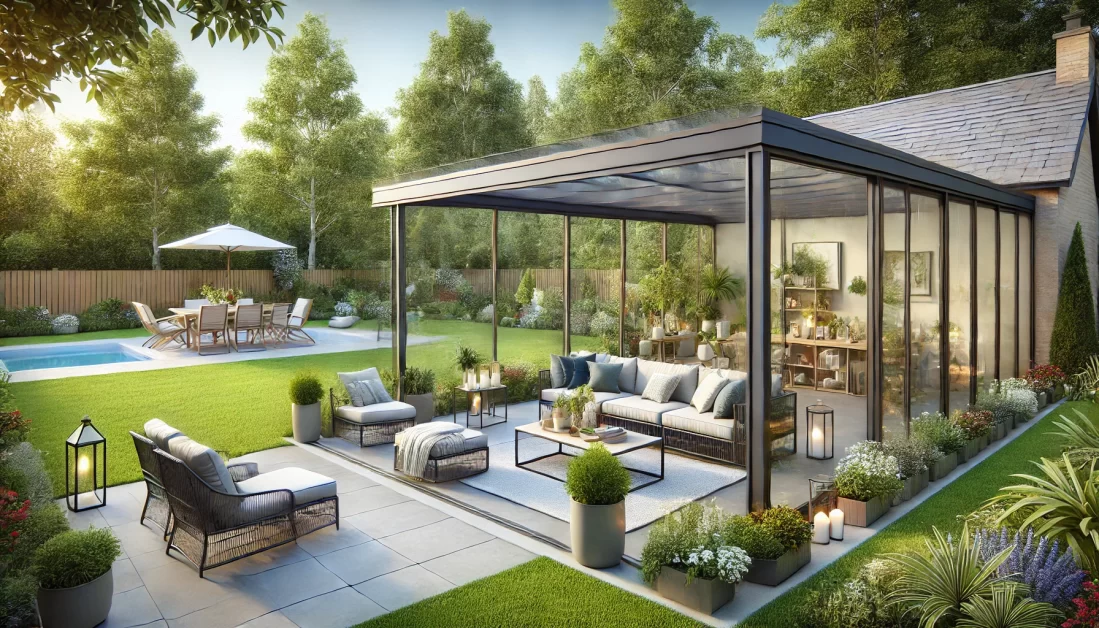
Key Benefits of Patio Enclosures
1. Protection from the Elements A primary advantage of enclosing your patio is safeguarding against unpredictable weather conditions. Whether it’s rain, wind, or harsh sunlight, an enclosure shields your outdoor space, ensuring you can enjoy it throughout the year.
Unlike open patios, enclosed spaces provide a comfortable retreat without having to worry about getting drenched or dealing with sweltering heat.
2. Year-Round Usability By enclosing your patio, you extend its usability far beyond the traditional summer months. With the right materials, you can enjoy this outdoor space in every season, turning it into a place for relaxation, socializing, or even work. Enclosed patios are perfect for creating a cozy environment in the winter with a cup of tea or hosting a summer barbecue sheltered from the sun.
3. Boosting Your Home’s Value A well-designed enclosure can increase the value of your property by adding functional square footage. It not only expands your living space but also enhances the aesthetic appeal of your home.
Potential buyers often view enclosed patios as a significant advantage, seeing it as an opportunity to enjoy an outdoor experience with fewer downsides.
Furthermore, this type of addition is typically more cost-effective than a traditional home expansion, making it a popular choice for homeowners looking to upgrade their space without breaking the bank.
Enclosing your patio bridges the gap between indoor and outdoor living, allowing you to relish fresh air without the nuisances of bugs, weather, or debris.
Patio Enclosures Cost: What You Need to Know
The cost of enclosing your patio depends on various factors like material choice, size, labor, and geographical location. When planning to enclose your patio, it’s essential to have a clear understanding of the associated costs.
From the materials used to labor and the location of your project, several factors can affect the final price tag. While enclosures can significantly enhance your outdoor living space, it’s crucial to balance your budget with the design, materials, and complexity of the project.
| Type | Cost per Square Foot | Total Cost Range (for average sizes) |
|---|---|---|
| Adding screens to existing patio | $10 – $25 | $2,000 – $5,000 |
| Building a new screened-in patio | $50 – $175 | $10,000 – $70,000 |
| Enclosed patio with walls and windows | $100 – $350 | $10,000 – $140,000 |
| Premade enclosure kit (DIY) | $10 – $20 | $1,500 – $5,000 |
| 3-season sunroom enclosure | $80 – $230 | $8,000 – $50,000 |
| 4-season sunroom enclosure | $200 – $400 | $20,000 – $84,000 |
| Solarium | $300 – $800 | $40,000 – $201,600 |
Patio Enclosures Cost Breakdown
Several factors contribute to the overall cost of building a patio enclosure:
- Materials: The type of materials you choose for your enclosure plays a huge role in the final price. For example, adding basic screens to an existing patio costs between $10 and $25 per square foot. On the other hand, building a completely new enclosure with walls and windows can range from $100 to $350 per square foot. High-end materials like glass or insulated panels for a four-season sunroom can push costs higher.
- Size: The square footage of the patio is another critical factor. Smaller patios cost less to enclose, while larger spaces come with higher expenses. For example, enclosing a 10’x10′ patio with screens might cost between $1,000 and $2,500, whereas the same-sized patio with walls and windows could cost up to $35,000.
- Labor: Labor is a significant cost in any construction project. While DIY kits may range from $1,500 to $5,000, professional installations can run into tens of thousands of dollars depending on the complexity and the type of enclosure you choose. Contractors typically charge $50 to $150 per hour, with specialized workers like landscape architects or electricians costing more for additional work.
- Location: Geographical location is another variable that can impact costs. For instance, areas with higher living costs or higher demand for contractors will naturally lead to increased pricing for labor and materials. Additionally, regional climate and weather patterns might influence the type of materials required, adding further to the cost.
Comparison of DIY Kits vs. Professional Installations
For budget-conscious homeowners, DIY patio enclosure kits can provide an affordable alternative. Ranging from $10 to $20 per square foot, these kits typically include screens or polycarbonate panels along with a canvas or aluminum roof.
However, they often lack insulation and don’t provide the same level of durability or design flexibility as custom-built enclosures. They also require a stable, level foundation to assemble, and the absence of professional installation could lead to challenges if not done properly.
In contrast, hiring a professional offers more design options, and better quality materials, and typically ensures longer-lasting results. Though more expensive—up to $400 per square foot for high-end enclosures—professionally built structures, such as four-season sunrooms, often include HVAC systems, and proper insulation, and are seamlessly integrated into the home.
Patio Enclosure Cost in Different Locations
The cost of enclosing a patio can also vary greatly depending on your location. Cities like Houston, Cincinnati, and Dallas see significant differences in pricing due to local market demands, contractor availability, and material costs.
- Houston: As a city with a generally warm climate, many homeowners opt for basic screened patios, which cost between $2,000 and $5,000. Full glass enclosures can go upwards of $80,000, depending on the size and features.
- Cincinnati: With more temperate weather, Cincinnati homeowners might prefer three-season or four-season sunrooms. These can range from $10,000 for smaller spaces to over $100,000 for larger, fully insulated options.
- Dallas: In Dallas, where high heat and sunlight are common concerns, homeowners often lean toward enclosed patios with better insulation and glass roofing, which can cost $50,000 or more for larger spaces. The high demand for construction professionals can drive up labor costs as well.
Cost Variances Based on Geography
Location impacts everything from delivery fees for materials to local building permits, which generally cost between $200 and $500. Additionally, the cost of living and labor shortages in certain areas can result in fluctuating prices.
For instance, regions with extreme weather may require specific materials—such as insulated glass for colder areas—which can elevate the overall cost. Conversely, in areas where labor is more affordable, such as certain parts of the Midwest, the cost for installation might be slightly lower.
Patio Enclosures Reviews: What Homeowners Are Saying
The reviews reflect a mixed experience. While some homeowners were pleased with the design and durability, others expressed deep dissatisfaction with both the product quality and customer service.
By carefully weighing the pros and cons, you can better understand what to expect and determine whether Enclosures is the right choice for your home improvement project.
With an overall rating of 1.9 across 114 reviews from various locations, many customers have expressed dissatisfaction with their experiences. Reading through these reviews can help you avoid costly mistakes and ensure that you make an informed decision.
Understanding Customer Feedback
Customer reviews provide invaluable insights into the quality and service of a product. Before committing, it’s important to examine feedback on:
- Quality: Look for reviews that detail how the enclosure holds up over time, particularly about weather conditions, material durability, and overall build quality.
- Durability: Consider the long-term performance of the enclosure. Are there complaints about parts breaking down prematurely, or has the structure remained sturdy even years after installation?
- Customer Service: Many reviews point to the importance of responsive and helpful customer service. Issues like poor communication, delays in repairs, or unfulfilled promises often crop up in dissatisfied customer reviews, and these are worth noting.
Reading customer feedback is essential because it reveals potential red flags. For instance, some homeowners reported difficulties in getting timely responses from the customer service team, particularly regarding repairs or follow-up on issues like leaking roofs or defective windows.
Pros and Cons Based on Reviews
When it comes to evaluating Patio Enclosures, customers’ opinions are divided. Here’s a breakdown of the common praise and complaints found in the reviews:
Pros:
- Durability: Some homeowners appreciated the structural strength and longevity of their enclosures, especially those who opted for higher-end materials.
- Design Flexibility: A few reviews highlight how customizable the enclosures are, with options ranging from screened patios to glass sunrooms, allowing homeowners to tailor their space to their needs.
- Customer Service (Positive Experiences): While complaints are prevalent, there are positive mentions of certain employees or sales representatives, such as Jimmy Green, who provided friendly and open communication throughout the process.
Cons:
- Pricing: A recurring complaint is the high cost relative to the perceived value. Many customers felt that the pricing for materials and installation was exorbitant compared to the quality delivered. For example, one customer from Rhode Island mentioned paying $60,000 to $90,000 for a product they felt was worth only a fraction of that.
- Installation Delays: Multiple reviewers pointed out delays in the installation process. Some projects, which were initially promised to be completed within days, extended to weeks or even months. Issues with subcontractors arriving late or not completing work on time also added to customer frustration.
- Product Quality: Several customers reported that the materials used were of subpar quality. Problems like leaky roofs, warped window frames, and broken hardware were commonly mentioned, with some homeowners facing ongoing issues with their enclosures.
- Customer Service (Negative Experiences): Many reviews indicate a lack of responsiveness from customer service. Homeowners often reported that it was difficult to get repair requests fulfilled, and in some cases, customers were asked to send videos or perform troubleshooting themselves before help was provided.
Patio Enclosure Ideas for Every Style
No matter your style, some solutions can elevate your outdoor space. From sleek and modern designs to cozy, nature-infused retreats, the right enclosure can help you enjoy your home’s outdoor areas all year long.
Get Inspired: Patio Enclosure Design Ideas
Looking for inspiration? Here are a few creative and functional ideas to help you design the perfect one for your lifestyle:
- Three-Season Room: If you live in an area with relatively mild winters, a three-season room could be a cost-effective yet functional option. These enclosures typically feature large windows or screens, allowing natural light and airflow during spring, summer, and fall. They provide shelter from rain or heat, while still offering that fresh outdoor feel.
- Acrylic Room Enclosures: For those who love the look of glass but want a more budget-friendly option, acrylic enclosures are the way to go. They offer a clear view of your surroundings without the high costs of glass and protect from weather elements, allowing you to enjoy the space more often.
- Glass Room Enclosures: For a luxurious upgrade, consider a glass. It allows you to enjoy the natural beauty of your outdoor space while staying protected from the elements. Insulated glass options also provide comfort year-round, ensuring the room doesn’t get too hot in the summer or too cold in the winter.
- Screen Room Enclosures: If bugs are a concern but you still want to feel the fresh air, screened-in patios are a great option. The see-through mesh keeps insects out while letting the breeze in, making it perfect for those who want to enjoy the outdoors without any distractions.
- Cathedral Sunrooms: For a truly breathtaking space, cathedral sunrooms offer high-vaulted ceilings that create an expansive, airy feel. Add floor-to-ceiling windows or skylights to further enhance the natural light and give your sunroom a dramatic, open look.
These designs cater to a wide variety of preferences, whether you’re aiming for simple elegance or bold architectural statements.
Enclosed Porches and Sunroom Inspiration
If you want to maximize the usability of your porch, enclosing it can turn it into a multi-purpose space that’s functional in all kinds of weather. Here are some ideas:
- Enclosed Porches: Turn your existing porch into an all-weather retreat by enclosing it with durable materials like glass or screens. This not only adds comfort and protection but also increases the overall value of your home. You can add cozy seating and weather-resistant décor to create a space perfect for lounging, entertaining, or even dining.
- Four-Season Sunrooms: A four-season sunroom is perfect if you’re looking to enjoy your outdoor space year-round. By integrating insulation and HVAC systems, these rooms can serve as a second living room, offering a perfect spot for family gatherings or quiet mornings with a cup of coffee. With fully customizable options for heating, cooling, and design, you can match the room’s décor with the rest of your home.
- Solariums: For plant lovers or those looking for a serene retreat, solariums are a fantastic option. Their all-glass design allows maximum sunlight to flood the space, making them ideal for cultivating indoor gardens. With a few stylish furniture pieces, solariums become the ultimate place to relax and recharge while staying connected to the beauty of nature.
Models of Retractable Patio Enclosures
Retractable enclosures are an excellent choice for homeowners who want flexibility in their outdoor space. These versatile models, such as the popular CORSO retractable, offer the best of both worlds—allowing you to open up the space to the outdoors or close it off when weather conditions are less favorable. Here’s why they are so appealing:
- Ease of Use: Retractables are designed with convenience in mind. With the touch of a button or a simple manual operation, you can effortlessly open or close the enclosure, depending on the weather or your preference. This is especially beneficial in places with fluctuating climates, where you might want to enjoy the sunshine one day and seek protection from rain the next.
- Versatility: These enclosures can be custom-designed to fit your patio’s dimensions and style. Whether you prefer glass, acrylic, or screens, retractable models can accommodate various materials and designs. When opened, they give the feel of an open patio; when closed, they protect without sacrificing views of the outdoors.
- Functionality: Beyond weather protection, retractable enclosures can add a layer of security and privacy to your patio. They also enhance energy efficiency by reducing the need for heating or cooling systems in the space. If you’re looking for a solution that offers adaptability, retractable enclosures are a smart investment.
For more reading about patio vs balcony.
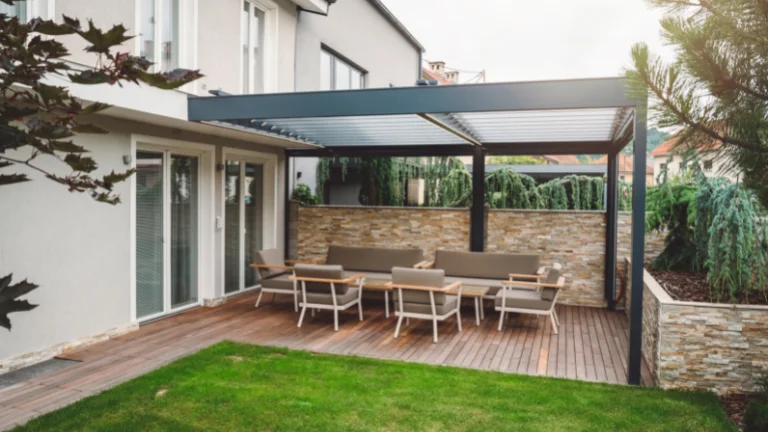
How to choose the right enclosure for your home
Assess Your Needs and Lifestyle
- Purpose: Determine what you primarily want to use the enclosure for. A sunroom might be ideal if you wish to extend your living space. Consider a screen room for a space to enjoy the breeze without the bugs.
- Seasonality: Decide if you want to use the space year-round or in warmer months. Sunrooms can be equipped with heating and cooling, while screen rooms are more suited for seasonal use.
Consider Your Home’s Architecture
- Style Compatibility: The enclosure should complement the architectural style of your home. Modern homes benefit from sleek glass enclosures, while traditional homes suit classic sunroom designs better.
- Integration: Think about how the enclosure will integrate with the existing structure. It should flow seamlessly with your home’s design rather than look like an afterthought.
Evaluate Material and Construction Options
- Materials: Choose materials that match your climate and maintenance preferences. Aluminum and vinyl are famous for their durability and low maintenance, while wood offers a natural look but requires more upkeep.
- Construction Quality: Opt for high-quality materials and craftsmanship to ensure your enclosure withstands weather conditions and lasts for years.
Understand Local Building Codes and Regulations
- Permits: Before planning your enclosure, check with your local building department to understand the necessary licenses and regulations. This can affect the size, design, and placement of your enclosure.
Set a Budget
- Cost Considerations: Be realistic about what you can afford. Screen rooms generally cost less than glass sunrooms. Include additional costs such as furniture, heating, cooling, and any required electrical work in your budget.
Choose the Right Contractor
- Experience and Reputation: Hire a contractor with experience in building patio enclosures. Check their references, reviews, and portfolio of completed projects.
- Communication: Choose someone who communicates clearly and is responsive to your questions and concerns throughout the project.
Plan for Comfort and Usability
- Heating and Cooling: If you plan to use the space year-round, consider installing heating and cooling solutions.
- Electrical and Lighting: Consider the electrical needs for lighting, outlets, and any entertainment systems you want in the enclosure.
Consider Future Maintenance
- Maintenance Requirements: Understand the maintenance required to keep your enclosure in top condition. Glass enclosures may require more cleaning, while screen rooms might need screen repairs. For more reading about cheap hot tub enclosures.

The installation process
Planning and Design
- Assessment: Evaluate your space to determine the best type of enclosure that fits your needs and budget.
- Design: Decide on the design, materials, and features you want in your enclosure. This might involve choosing between a screen room, sunroom, or glass enclosure and selecting the types of windows, doors, and roofing materials.
- Permits: Obtain necessary permits from your local building authority, ensuring your project complies with local codes and regulations.
Site Preparation
- Foundation Preparation: The area where the enclosure will be installed must be prepared. This might include leveling the ground, pouring a concrete slab, or reinforcing an existing patio to support the new structure.
- Utility Setup: If your enclosure requires electricity, plumbing, or HVAC connections, this is the time to install or prepare those systems.
Construction
- Framework: The first physical step is constructing the frame of your enclosure using materials such as aluminum, wood, or vinyl.
- Roofing and Walls: The roof and wall elements are added once the frame is up. For sunrooms or glass enclosures, this involves installing glass panels or windows. For screen rooms, durable screen material is installed.
- Doors and Windows: Installing doors and windows comes next, providing access and ventilation to your enclosed space.
Finishing Touches
- Interior Finishing: This includes any interior work such as drywall, painting, flooring, and installing electrical fixtures.
- Exterior Finishing: Ensures the enclosure is sealed and protected from the elements, matching your home’s exterior for a seamless look.
- Utility Finalization: Final installations for electrical wiring, lighting, heating, or cooling systems are completed.
Inspection and Cleanup
- Inspection: If required, a final inspection by the local building authority ensures the project complies with all codes and regulations.
- Cleanup: After clearing the construction debris, your new enclosure is ready for furnishing and use.
Tips for a Smooth Installation
- Hire a reputable contractor: Choose a contractor with experience. Check their references and past work.
- Communication: Keep open lines of communication with your contractor to ensure your project meets your expectations.
- Quality Materials: Investing in quality materials can extend life and reduce maintenance costs over time.
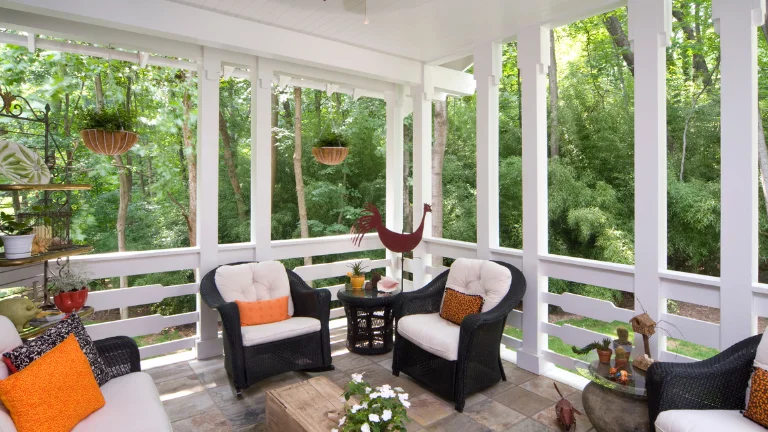
Top 5 Reasons I Love Porch Enclosure Systems
1. High-Quality Materials: Porch Enclosure Systems uses durable, high-quality materials like crystal clear vinyl panels, glass-like curtains, and weather-resistant hardware. This ensures their enclosures stand the test of time.
2. Innovative Design: I appreciate their forward-thinking approach to porch and patio enclosures. They offer creative solutions to block wind, rain, snow, pollen, dust, and cold when needed.
3. Seasonal Use: Their enclosures are designed for seasonal, winter, and weather use so I can enjoy my outdoor space year-round. The curtains easily roll up or down as needed.
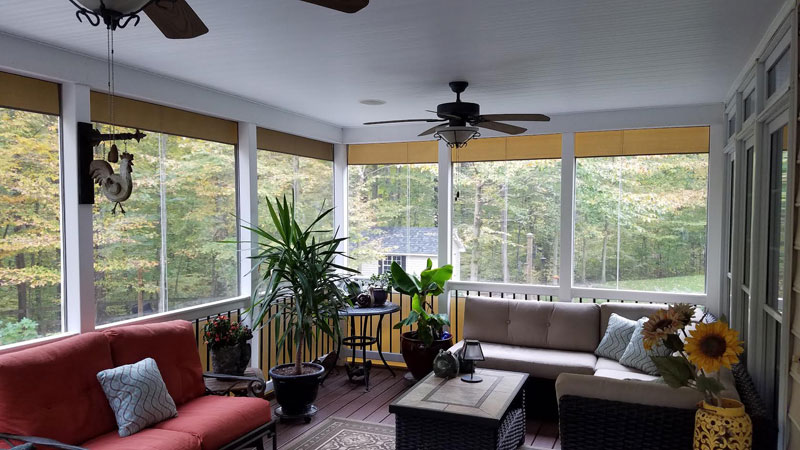
4. Customizable: Different enclosure options allow me to perfectly customize my outdoor area to suit my needs and style. This makes the space more functional and enjoyable.
5. Great Investment: The top-notch materials and innovative design make Porch Enclosure Systems a worthwhile investment in my home that will last for years. I know I’m getting great value for my money.
For more about outdoor relaxation & wellness, you can visit Hot Tub Patio. On the other hand, check out Garden and Patio to improve your outdoor space with landscaping and beautification.
Patio Enclosures DIY: Is It Right for You?
By following this step-by-step guide and carefully selecting your kit, you can create a beautiful and functional enclosure that enhances your home and outdoor living space.
While DIY can be a rewarding process, be prepared for the time and effort it requires, and always ensure safety is a top priority throughout the installation.
How to Choose a Patio Enclosure Kit
When choosing an enclosure kit, there are several important factors to consider. The right kit can make your project easier and more cost-effective, but selecting one that meets your needs requires careful attention to the following:
- Ease of Installation: Look for a kit that includes clear, detailed instructions and all necessary components. Some kits are designed for quick assembly, while others may require advanced skills and more time. If you’re a beginner, opt for a user-friendly kit that simplifies the process.
- Material Quality: The materials you select will have a lasting impact on the durability and aesthetics. High-quality materials, such as aluminum frames or durable polycarbonate panels, will ensure your enclosure withstands the elements and remains visually appealing for years. Be cautious of cheaper kits that might cut corners on quality, leading to long-term maintenance issues.
- Cost-Effectiveness: DIY kits often promise significant savings, but be sure to compare the cost of the kit with potential additional expenses, such as tools, foundation work, or even hiring extra help for complex tasks. While a lower upfront cost can be appealing, consider the long-term value and durability of the materials to avoid costly repairs down the line.
By keeping these key elements in mind, you can select a kit that fits your budget and skill level while still delivering a high-quality result.
Step-by-Step Guide to Installing a DIY Patio Enclosure
Tackling a DIY enclosure project requires careful planning and execution. While the process can vary depending on the type of kit you choose, here’s a simplified guide to help you through the general installation steps:
- Prepare the Area: Before installation, ensure your patio space is level and clean. If your kit requires a foundation, such as concrete or pavers, this should be completed before moving on to assembly.
- Unpack and Organize Materials: Lay out all the components from your kit, making sure everything listed in the instructions is present. Take the time to read through the manual thoroughly so you’re familiar with each step.
- Assemble the Frame: Begin by constructing the main framework of your enclosure. Most kits come with pre-cut parts that connect easily with bolts or screws. It’s important to ensure that each section is level and aligned correctly before tightening any connections.
- Install the Roof and Walls: Once the frame is secure, install the roof panels or covering, ensuring proper alignment and sealing to prevent leaks. For enclosures with screen or polycarbonate walls, attach these panels to the frame, securing them as directed by the kit instructions.
- Seal and Finalize: After the primary structure is in place, inspect all joints, seams, and edges to ensure they are properly sealed. This will protect the enclosure from moisture and drafts. Lastly, install any finishing touches such as doors, windows, or trim that may be included in your kit.
- Test for Stability and Functionality: Before calling the project complete, test the stability of the enclosure and ensure that all doors, windows, or retractable features operate smoothly. If any issues arise, now is the time to correct them before long-term use.
The Benefits of Patio Covers vs Full Enclosures
Patio covers are a cost-effective way to improve your outdoor space, but full enclosures offer greater protection, comfort, and long-term benefits. Consider your climate, privacy needs, and how often you plan to use your outdoor space when deciding between the two options.
Patio Covers: The Affordable Alternative
Patio covers are an excellent choice for homeowners who want to enhance their outdoor space without breaking the bank. Here’s a comparison of the advantages and limitations of patio covers versus full enclosures:
Pros of Patio Covers:
- Affordability: Patio covers are the most budget-friendly option. They provide shade and protection from rain, allowing you to enjoy your patio more frequently without the expense of enclosing the entire area. Materials like aluminum, wood, or vinyl are often used, keeping costs low.
- Ease of Installation: Compared to full enclosures, patio covers are simpler and faster to install. The project can typically be completed in a few days, causing minimal disruption.
- Open-Air Feel: Patio covers allow you to maintain an open, airy feel while still shielding your outdoor space from the elements. This makes them ideal for homeowners who enjoy a breeze and want to stay connected to their yard or garden.
Cons of Patio Covers:
- Limited Protection: While patio covers offer overhead protection from rain and sun, they don’t guard against wind, insects, or cooler temperatures. This limits the usability of the space during certain times of the year.
- Less Privacy: Patio covers leave the sides of your outdoor space exposed, offering little in the way of privacy. If your home is in a more populated area, this could be a drawback.
Pricing Differences: Patio covers are significantly cheaper than full enclosures, making them an attractive option for those with a limited budget. On average, patio covers can range from $1,500 to $5,000, depending on the materials used and the size of the area.
When to Choose a Full Patio Enclosure Over a Patio Cover
In certain situations, a full enclosure is a far better investment than a patio cover, offering year-round usability and increased property value. Here’s when it makes more sense to go for a full enclosure:
1. Climate Considerations:
If you live in a region with extreme weather—whether it’s heavy rain, intense sun, or even snow—a full enclosure provides significantly more protection than a patio cover. For example, in areas like Texas, where the weather can range from blazing heat to heavy downpours, a full enclosure can ensure that your outdoor space is usable no matter the season.
2. Year-Round Usage:
A full enclosure, especially one with screens or glass, allows you to enjoy your outdoor area throughout the year. Screen enclosures keep out bugs and debris while allowing airflow, while glass enclosures provide insulation and comfort. If you want to transform your patio into a true extension of your living space, an enclosure is the way to go.
3. Privacy Needs:
Unlike patio covers, full enclosures provide added privacy. With the sides of your patio fully enclosed, you can create a private oasis where you can relax without worrying about neighbors or passersby.
4. Long-Term Investment:
Full enclosures add significant value to your home. They increase your property’s square footage and offer a versatile space that can be used as an additional living room, dining area, or sunroom. If you’re looking for a long-term investment that increases your home’s value and functionality, a full enclosure is the better option.
Depending on the materials and design, full enclosures can range from $10,000 to $70,000 or more, but the added value to your home makes it a worthwhile investment.
Windows & Doors for Patio Enclosures
Customizing with Windows & Doors
The right windows and doors can make a huge difference. Not only do they enhance the look, but they also improve functionality.
For instance, large windows can flood your space with natural light, while sliding glass doors make it easy to blend indoor and outdoor living. You can also choose materials that offer better insulation, keeping your space comfortable year-round.
Planning Your Perfect Patio Enclosure
Step 1: Get Inspired
Before diving into your patio project, take time to explore different designs and styles. Look at reviews, browse product catalogs, and consider the layout that would best suit your needs. Whether it’s modern glass enclosures or cozy screened-in porches, getting inspired is the first step to planning your dream space.
Step 2: Plan Your Patio Enclosure or Sunroom
Once you’re inspired, it’s time to plan! Start by setting a budget—this will help guide decisions on materials and design. Next, consider whether you’ll hire a contractor or tackle a DIY project. Remember, high-quality materials and expert installation can make all the difference in durability and comfort.
Retractable Patio Enclosures Benefits
Why Consider Retractable
Retractable enclosures give you flexibility. On warm, sunny days, you can open them up to enjoy the outdoors. When the weather turns, just close the enclosure to keep out rain or wind. They’re also low-maintenance, easy to clean, and adapt well to different seasons, making them a great choice for anyone looking to maximize their outdoor living space.







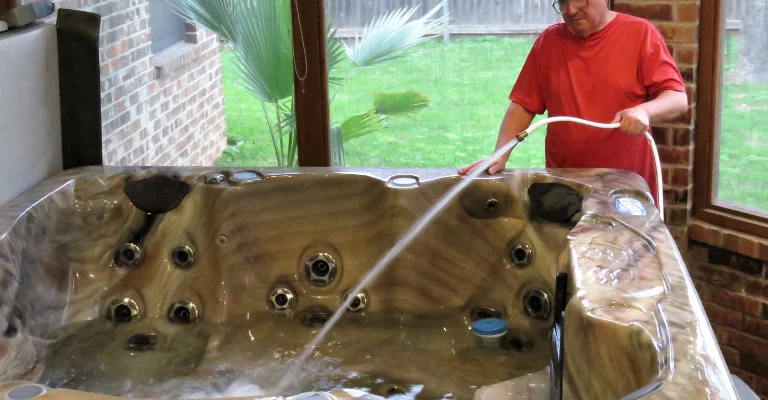

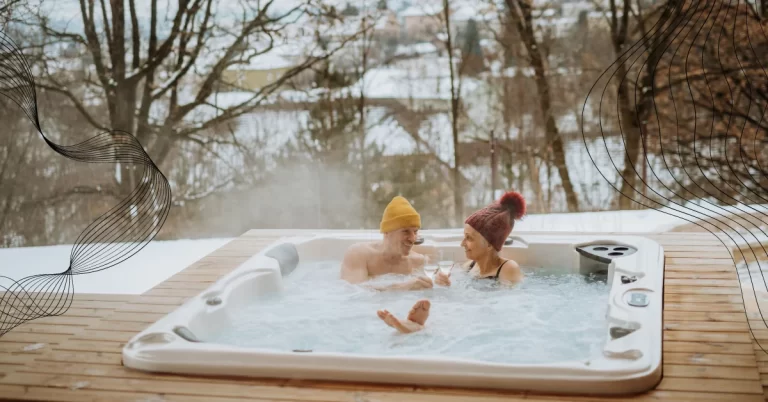
2 Comments